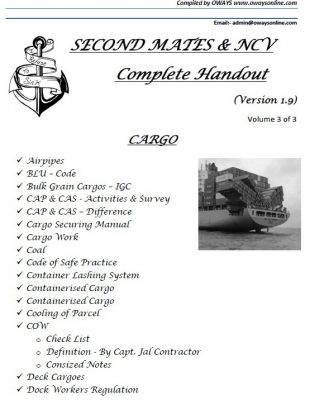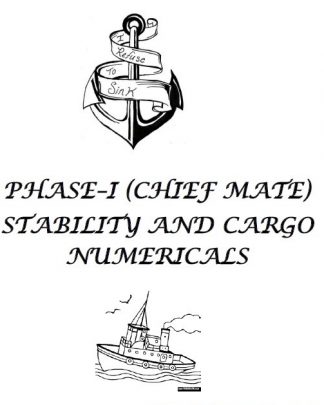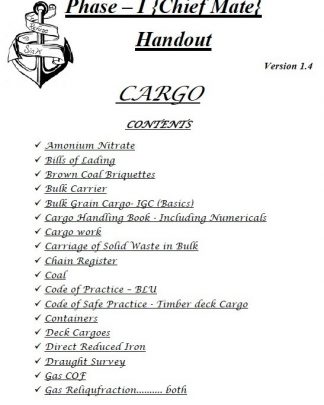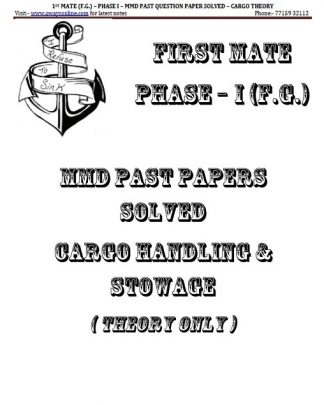Documents as a Mate you would sign after loading Direct Reduced Iron (DRI):
- Mate’s Receipt:- A mate’s receipt is usually a printed form, often with handwritten entries which acknowledges on behalf of the ship the receipt of the goods. It is evidence that the goods specified in it have been delivered to and received by the ship (It is signed by chief officer of the receiving ship). Usually the person to whom the mate’s receipt is given is the person entitled to a bill of lading in exchange for the return of the mate’s receipt.
- Shipper’s Declaration:- A Shipper’s Declaration is required under the IMO Code of Safe Practice for Solid Bulk Cargoes (BC Code) to be made by the shipper of a hazardous solid bulk cargo, e.g. coal, for the guidance of the master The Shipper’s Declaration also lists any special precautions required and states where emergency procedures may be found, e.g. in the Coal section of the BC Code, and reproduces relevant extracts. A Master’s Response Sheet may be issued by a shipper to the master after loading a hazardous bulk cargo in an effort to obtain information on the behaviour of the cargo during the voyage, where this behaviour does not correspond to that stated on the Shipper’s Declaration.
- Stowage Plan: – Also known as Cargo plan or the hold distribution plan shows the commodity, tonnage and/or measurement of cargo in each hold. The plan may be produced by one of the ship’s officers to provide a record of the loading as observed and measured by ship’s personnel, in which case it may also provide information about the bunkers carried and the vessel’s draught, trim and stability. Alternatively, stowage plan may be produced by someone from the loading installation to record the quantities loaded in each hold. A stowage plan provide by shore-based staff will normally show the shore values for the tonnages loaded, regardless of whether or not these are the figures used in the bill of lading.
- Cargo Manifest: – A cargo manifest is issued by the shippers in the loading port and is based upon the information contained in the bills of lading. It provides brief details of the ship and the loading and discharge ports and list details of the cargo carried. Details include the B/L numbers, contents, gross weight and freight. Copies of the manifest, if available are retained by the master, who will give copies to the authorities in the discharge port or ports visited en-route, if required.
Hazards of DRI and Derivatives:
- The principal hazards of all cargoes of DRI and its derivatives are two fold:
- Reaction with air
- Firstly, they will react with the oxygen present in the air, thereby producing heat. This effect can run away in spectacular fashion, leading to auto-oxidation (burning) of the iron, in which the stow becomes incandescent as the temperatures approach 1,000o
- C. This tendency is successfully prevented in most practical applications by densifying the DRI pellets at temperatures exceeding
- 650oC to produce HBI.
- Whereas self-heating is dangerous and alarming, it is a gradual and progressive event that can often be diagnosed early, affording masters time to obtain advice from ashore and institute suitable safety measures.
Reaction with moisture: – The second hazard is again related to the reactivity of iron, this time with moisture or water. The result is the generation of hydrogen gas, which is explosive over a very wide range of concentrations and, in practical situations, displays an alarming readiness to be ignited. Explosions of hydrogen in air are extremely violent and rapid and an unfortunate master has no time in which to react to an explosion.
All Types of DRI:
- Fines are now defined as particles up to 6.35mm (¼”) in size.
- Cargo spaces shall be clean, dry and free from salt and residues of previous cargoes. Wooden fixtures and combustible materials shall be removed.
- The carrier’s representative is to have reasonable.
- Access to stockpiles and loading installations for inspection.
- Prior to loading, the shipper shall provide the Master.
- With a certificate issued by a competent person stating the cargo is suitable for shipment and that it confirms with the requirements of the Code in terms of particle size, moisture content and temperature.
- A similar certificate shall be provided after loading relating to the whole consignment.
- The shipper shall provide comprehensive information.
- On the cargo and safety procedures to be followed in the event of an emergency.
- No cargo shall be loaded or transferred during precipitation and non-working hatches shall be kept closed.
- The cargo shall not be accepted when its temperature is in excess of 65oC, or its moisture content exceeds the permitted value, or if the quantity of fines exceeds the permitted value, where appropriate.
- The cargo temperatures shall be monitored during loading and recorded in a log.
- The cargo shall be trimmed in accordance with the relevant provisions of the Code.
- Adjacent tanks other than double bottom tanks shall be kept empty during the voyage.
- Weather tightness shall be maintained throughout the voyage.
- The bilge wells shall be clean and dry and protected from ingress of cargo.
- Precautions shall be taken to protect personnel equipment etc. from the dust of the cargo.
- During handling of the cargo, “NO SMOKING” signs shall be posted and no naked lights or other ignition sources permitted.
- Suitable precautions shall be taken before entering cargo spaces, which be depleted of oxygen and/or contain a flammable atmosphere.
- The ship shall be provided with a detector suitable for measuring hydrogen in an oxygen depleted atmosphere and for use in a flammable atmosphere.
- Cargo temperatures and hydrogen concentrations in hold atmospheres shall be measured at regular intervals during the voyage.
- If the hydrogen concentration exceeds 1% or the cargo temperature exceeds 65oC, appropriate safety precautions shall be taken. If in doubt, expert advice shall be sought.
- Bilge wells shall be checked regularly for the presence of water.
- All records of temperature, hydrogen and oxygen measurements, where appropriate, are to be retained on board for 2 years.
- The hydrogen concentration shall be measured in the holds prior to opening the hatch covers.
DIRECT REDUCED IRON (B)
Direct Reduced Iron (DRI) (B) is a metallic material of a manufacturing process formed by the reduction (removal of oxygen) of iron oxide at temperatures below the fusion point of iron. Cold-moulded briquettes should be defined as those which have been moulded at a temperature of under 650oC or which have a density of less than 5.0 g/cm3.
| Angle of repose | Bulk density (k/gm3) | Stowage factor (m3/t) | Size | Class | Group |
| Not applicable | More than 2000 | Up to 0.5 | Lumps and pellets: Average particle size 6 mm to 25 mm with up to 5% fines (under 4 mm) | MHB | B |
| Cold-moulded briquettes: Approximate maximum dimensions 35 mm to 40 mm |
HAZARD: DRI may react with water and air to produce hydrogen and heat. The heat produced may cause ignition. Oxygen in an enclosed space may be depleted.
STOWAGE & SEGREGATION: “Separated from” goods of classes 1 (Division 1.4S), 2, 3, 4 and 5 and class 8 acids in packaged form (see IMDG Code). “Separated from” solid bulk materials of classes 4 and 5. Goods of class 1, other than Division 1.4S, should not be carried in the same ship. Boundaries of compartments where this cargo is carried shall be resistant to fire and liquid.
HOLD CLEANLINESS: The cargo spaces shall be clean, dry and free from salt and residues of previous cargoes. Wooden fixtures such as battens shall be removed.
WEATHER PRECAUTIONS: This cargo shall be kept as dry as practicable before loading, during loading and during voyage. This cargo shall not be loaded during precipitation. During loading of this cargo all non-working hatches of the cargo spaces to which this cargo are loaded or to be loaded shall be closed.
LOADING: Where practicable, adjacent ballast tanks, other than double-bottom tanks, shall be kept empty. Weather deck closures shall be inspected and tested to ensure integrity. This cargo shall not be accepted for loading if the temperature is in excess of 65°C (150°F).
PRECAUTIONS: Prior to loading this cargo, the shipper shall provide the master with a certificate issued by a person recognized by the competent authority of the country of shipment stating that the cargo, at the time of loading, is suitable for shipment. Shippers shall certify that the cargo conforms to the requirement of this Code. Prior to shipment, this cargo shall be aged for at least 72 hours, or treated with an air passivation technique, or some other equivalent method that reduces the reactivity of the material to at least the same level as the aged product. Hatches of the cargo space for this cargo shall be sealed. All ventilators and other openings of the cargo spaces shall be closed to maintain an inert atmosphere.
A. The shipper shall provide necessary specific instructions for carriage, either:
1. Prior to loading, provision should be made to introduce the inert gas at tank top level so that the whole of the cargo space can be maintained at a low oxygen level throughout the voyage. The cargo spaces shall be maintained under an inert atmosphere containing less than 5% oxygen. The hydrogen content of the atmosphere in the cargo spaces shall be maintained at less that 1% by volume; or
2. that the cargo has been manufactured or treated with an oxidation and corrosion-inhibiting process which has been proved, to the satisfaction of the competent authority, to provide effective protection against dangerous reaction with seawater or air under shipping conditions.
B. The provision of paragraph A above may be waived or varied if agreed to by the competent authorities of the countries concerned, taking into account the sheltered nature, length, duration, or any other applicable conditions of any specific voyage.
The ship selected for the carriage of this cargo shall be suitable in all respects for the carriage of this cargo. Except as provided for under paragraph A2 above, any material which is wet or is known to have been wetted should not be accepted for carriage in bulk. The cargo shall be loaded, stowed and transported under dry conditions. Appropriate precautions shall be taken to protect machinery and accommodation spaces from the dust of the cargo. Bilge wells of the cargo spaces shall be protected from ingress of the cargo. Due consideration shall be paid to protect equipment from the dust of the cargo. Persons, who may be exposed to the dust of the cargo, shall wear protective clothing, goggles or other equivalent dust eye-protection and dust filter masks, as necessary. Radars and exposed radio communication equipment of the ship which carry this cargo shall be protected from the dust of this cargo. Bilge wells shall be clean, dry and covered as appropriate, to prevent ingress of the cargo. Cargo spaces containing this cargo and adjacent spaces may become oxygen-depleted. Flammable gas may also build up in these spaces. All precautions shall be taken upon entering these spaces.
VENTILATION: The cargo spaces carrying this cargo shall not be ventilated during voyage.
CARRIAGE: For quantitative measurements of oxygen and hydrogen, suitable detectors for each gas or combination of gases shall be on board while this cargo is carried. The detectors shall be suitable for use in an atmosphere without oxygen and of certified safe type for use in explosive atmosphere. The concentrations of these gases in the cargo spaces carrying this cargo shall be measured regularly, during voyage, and the results of the measurements shall be recorded and kept on board. No smoking, burning, cutting, chipping or other source of ignition shall be allowed in the vicinity of the cargo spaces containing this cargo.
DISCHARGE: No special requirements.
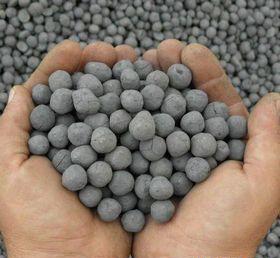
CLEAN-UP: No special requirements.
EMERGENCY ACTION IN THE EVENT OF FIRE: Batten down. Do not use water. Seek expert advice. Early application of an inert gas to a smouldering situation may be effective. If a fire situation develops, the ship should make for the nearest suitable port and neither water, steam nor additional carbon dioxide should be used at this stage. If nitrogen gas is available, the use of this gas to keep the oxygen concentration down will contain the fire. Preparations should be made for grab discharge if serious heating occurs.
MEDICAL FIRST AID: Refer to the Medical First Aid Guide (MFAG), as amended.
DIRECT REDUCED IRON (A)
A metallic grey colloid material emanating from a ensification process whereby the direct reduced iron (DRI) feed material is at a temperature greater than 650OC at time of moulding and has a density greater than 5.0 g/cm3. Fines (under 4 mm) not to exceed 5%.
| Angle of repose | Bulk density (k/gm3) | Stowage factor (m3/t) | Size | Class | Group |
| Not applicable | 2500 – 3300 | 0.3 to 0.4 (To be verified by the shipper) | Length 90 mm to 130 mm, Width 80 mm to 100 mm, Thickness 20 mm to 50 mm, Briquette weight 0.5 to 2.0 kg, Fines: under 4 mm | MHB | B |
HAZARD: Material may slowly evolve hydrogen after contact with water. Temporary self-heating of about 30oC may be expected after material handling in bulk. This cargo is non-combustible or has a low fire-risk.
STOWAGE & SEGREGATION: “Separated from” goods of classes 1 (Division 1.4), 2, 3, 4 and 5 and class 8 acids in packaged form (see IMDG Code). “Separated from” solid bulk materials of classes 4 and 5. “Separated longitudinally by an intervening complete compartment or hold from” goods of class 1 other than Division 1.4 C. Boundaries of compartments where this cargo is carried shall be resistant to fire and liquid.
HOLD CLEANLINESS: The cargo spaces shall be clean, dry and free from salt and residues of previous cargoes.
WEATHER PRECAUTIONS: This cargo shall be kept as dry as practicable during loading and the voyage. Open storage is acceptable prior to loading. This cargo shall not be loaded during precipitation. During loading of this cargo all non-working hatches of the cargo spaces into which this cargo is loaded or to be loaded shall be closed.
LOADING: Trim in accordance with the relevant provisions required under sections 4 and 5 of the Code. Due consideration shall be paid to evenly spreading the cargo across the tanktop to minimize the concentration of fines. This cargo shall not be loaded when the temperature is in excess of 65°C (150°F). Prior to loading wooden fixtures such as battens shall be removed.
PRECAUTIONS: Prior to loading this cargo, the shipper shall provide the master with a certificate issued by a person recognized by the competent authority of the country of shipment stating that the cargo, at the time of loading, is suitable for shipment and does not contain fines more than 5%. Where practicable, ballast tanks adjacent to the cargo spaces containing this cargo, other than double-bottom tanks, shall be kept empty. Weather deck closures shall be inspected and tested to ensure integrity. During discharge, a fine spray of fresh water may be applied to this cargo for dust control. The cargo temperature shall be monitored during loading. The shipper may provide advice in amplification of this Code but the advice shall not be contrary thereto in respect of safety. Appropriate precautions shall be taken to protect machinery and accommodation spaces from the dust of the cargo. Bilge wells of the cargo spaces shall be protected from ingress of the cargo. Due consideration shall be paid to protect equipment from the dust of the cargo. Persons, who may be exposed to the dust of the cargo, shall wear protective clothing, goggles or other equivalent dust eye-protection and dust filter masks, as necessary. Radars and exposed radio communication equipment of the ship which carry this cargo shall be protected from the dust of this cargo. During handling of this cargo “NO SMOKING” signs shall be posted on decks and in areas adjacent to cargo spaces and no naked lights shall be permitted in these areas. Cargo spaces containing this cargo may become oxygen-depleted and precautions shall be taken upon entering the cargo spaces. Bilge wells shall be clean, dry and covered as appropriate, to prevent ingress of the cargo. Cargo spaces containing this cargo and adjacent spaces may become oxygen-depleted. Flammable gas may also build up in these spaces. All precautions shall be taken upon entering these spaces.
VENTILAION Surface ventilation only, either natural or mechanical, shall be conducted, as necessary, during the voyage for this cargo. Ventilation shall be such that escaping gases cannot penetrate living quarters on or under deck.
CARRIAGE: For quantitative measurements of hydrogen, a suitable detector shall be on board while this cargo is carried. The detector shall be suitable for use in an atmosphere without oxygen and of certified safe type for use in explosive atmosphere. The concentrations of hydrogen in the cargo spaces carrying this cargo shall be measured regularly, during voyage, and the results of the measurements shall be recorded and kept on board.
DISCHARGE: No special requirements.
CLEAN-UP: No special requirements.
EMERGENCY ACTION IN THE EVENT OF FIRE: Batten down. Do not use water. Seek expert advice. Early application of an inert gas to a smouldering situation may be effective. Preparations should be made for grab discharge if serious heating occurs.
MEDICAL FIRST AID: Refer to the Medical First Aid Guide (MFAG), as amended.
DRI Hazards:-
- DRI may react with water and air to produce hydrogen and heat.
- The heat produced may cause ignition.
- Oxygen in an enclosed space may be depleted.
DRI Precautions:-
- Prior to loading this cargo, the shipper shall provide the master with a certificate issued by a person recognized by the competent authority of the country of shipment stating that the cargo, at the time of loading, is suitable for shipment.
- Shippers shall certify that the cargo conforms to the requirement of this Code.
- Prior to shipment, this cargo shall be aged for at least 72 hours, or treated with an air passivation technique, or some other equivalent method that reduces the reactivity of the material to at least the same level as the aged product.
- Hatches of the cargo space for this cargo shall be sealed. All ventilators and other openings of the cargo spaces shall be closed to maintain an inert atmosphere.
- The shipper shall provide necessary specific instructions for carriage, either:
- Prior to loading, provision should be made to introduce the inert gas at tank top level so that the whole of the cargo space can be maintained at a low oxygen level throughout the voyage. The cargo spaces shall be maintained under an inert atmosphere containing less than 5% oxygen. The hydrogen content of the atmosphere in the cargo spaces shall be maintained at less that 1% by volume;
OR
- That the cargo has been manufactured or treated with an oxidation and corrosion-inhibiting process which has been proved, to the satisfaction of the competent authority, to provide effective protection against dangerous reaction with seawater or air under shipping conditions.
- The provision of paragraph A above may be waived or varied if agreed to by the competent authorities of the countries concerned, taking into account the sheltered nature, length, duration, or any other applicable conditions of any specific voyage.
- The ship selected for the carriage of this cargo shall be suitable in all respects for the carriage of this cargo. Except as provided for under paragraph A2 above, any material which is wet or is known to have been wetted should not be accepted for carriage in bulk.
- The cargo shall be loaded, stowed and transported under dry conditions.
- Appropriate precautions shall be taken to protect machinery and accommodation spaces from the dust of the cargo. Bilge wells of the cargo spaces shall be protected from ingress of the cargo.
- Due consideration shall be paid to protect equipment from the dust of the cargo.
- Persons, who may be exposed to the dust of the cargo, shall wear protective clothing, goggles or other equivalent dust eye-protection and dust filter masks, as necessary.
- Radars and exposed radio communication equipment of the ship which carry this cargo shall be protected from the dust of this cargo.
- Bilge wells shall be clean, dry and covered as appropriate, to prevent ingress of the cargo.
- Cargo spaces containing this cargo and adjacent spaces may become oxygen-depleted. Flammable gas may also build up in these spaces. All precautions shall be taken upon entering these spaces.
Stowage plan Precautions for loading DRI:
STOWAGE & SEGREGATION: “Separated from” goods of classes 1 (Division 1.4S), 2, 3, 4 and 5 and class 8 acids in packaged form (see IMDG Code). “Separated from” solid bulk materials of classes 4 and 5. Goods of class 1, other than Division 1.4S, should not be carried in the same ship. Boundaries of compartments where this cargo is carried shall be resistant to fire and liquid.
